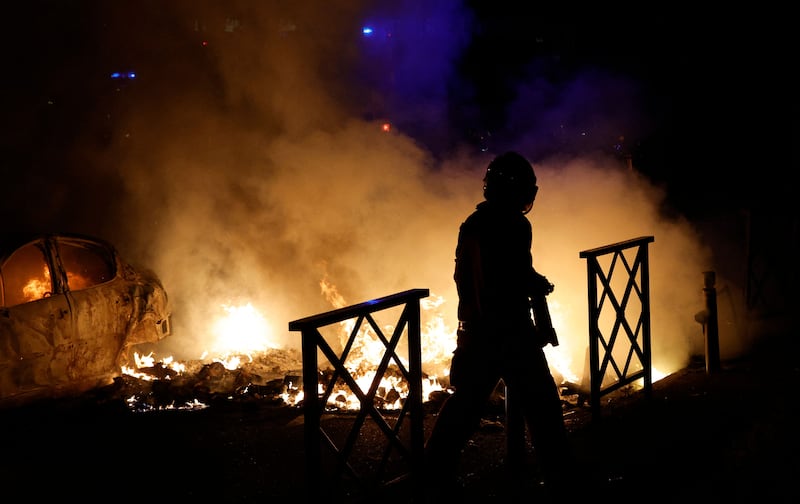More than 6,000 people marched in the Paris suburb of Nanterre on Thursday afternoon, many of them with raised fists and chanting “Justice for Nahel”.
The words, “We will avenge you,” were daubed in graffiti on walls in the area where 17-year-old Nahel M was raised by his single mother, Mounia, and where he was shot dead on Tuesday morning by a motorcycle policeman after ignoring an order to stop.
Mounia led the march, perched atop a flatbed truck and wearing a white T-shirt emblazoned with the words, “Justice for Nahel”. At least one protester carried an Algerian flag as the victim was of Algerian origin.
The fatal shooting sparked rioting on Tuesday and Wednesday nights and more violence started at the end of the protest march on Thursday, near to the Place Nelson Mandela, where Nahel died.
‘No one will be left behind’: Ukraine struggles to return Mariupol defenders from Russia three years after port siege
‘The scene was like the end of the world’: Thailand reels from earthquake
It took about 40 seconds for US immigration officers to lift the Turkish student off the streets of Boston
Trump proves topical at tropical gathering on Chinese island
Youths wearing balaclavas and hoodies began hurling projectiles at helmeted riot police. Police fired back. The youths set fires and by 4.30pm, the sky over Nanterre was filled with black smoke.
Interior minister, Gérald Darmanin, said he would deploy 40,000 police and gendarmes across the country on Thursday night in the hope of quelling the violence. Public transport was to stop at 9pm in immigrant areas of the Paris region.
On Wednesday night, rioters attacked dozens of schools and town halls, train tracks, metro stations and traffic lights, ignoring official pleas for calm. At least 180 people were arrested and 170 police officers were injured.
Officials have repeatedly said the youths are only harming themselves and their families by destroying infrastructure in the areas where they live. A network of parents banded together to protect a school in Nanterre but gave up when police told them it was too dangerous.
The same scenario was repeated until the early hours of Thursday morning. Teenagers on motorcycles acted as spotters for hooded youths who built barricades of rubbish bins and cars, which they set on fire.
Riot police charged, firing stun guns and tear gas grenades. The youths seem to have an inexhaustible supply of east European fireworks in crates labelled “crackling chrysanthemums”. They used firework mortars to attack police, cheering each time police retreated. An apartment block in the Lyon suburb of Villeurbanne was destroyed in this way by firework mortars on Wednesday night. Its residents had to be evacuated.
One of the most alarming things for French authorities is that the violence spilt over from the immigrant banlieues to middle class areas of some cities, including Amiens, Boulogne-Billancourt and Lille.
[ Protests erupt across France over police killing of 17-year-old Arab boyOpens in new window ]
President Emmanuel Macron’s emphasis seemed to shift on Thursday from the compassion and outrage he expressed on Wednesday to a law and order stance. “Violence against police stations, schools, town halls, against the Republic, is unjustifiable,” he said. The previous day he said, “Nothing. Nothing justifies the death of a youth.”
The prosecutor of Nanterre, Pascal Prache, held a 10-minute news conference where he said: “The legal conditions for the use of the [policeman’s] weapon have not been met.” The 38-year-old policeman who fired the fatal shot remains in custody and has been formally placed under investigation for voluntary homicide.
Mr Prache also provided details of the sequence of events on Tuesday morning. Nahel M had a record of failing to obey police orders to stop and was summoned to juvenile court in September for that offence.

Just before 8am on Tuesday, Nahel was seen driving in a bus lane, then ran a red light when police tried to stop him. The prosecutor said the yellow Mercedes with a sunroof committed several other traffic violations, including endangering a pedestrian and a cyclist, before two motorcycle police officers accosted Nahel when the car was forced to stop in traffic.
The crisis has revived memories of the violent deaths of at least a half dozen Arab and African men at the hands of French police and led to comparisons with the United States.
Green leader, Marine Tondelier, denounced “the Americanisation of the [French] police” and Le Monde’s editorial compared Nahel’s death to that of George Floyd in Minneapolis in May 2020. In both cases, police brutality was filmed by a bystander, posted on social media and inflamed public opinion.














